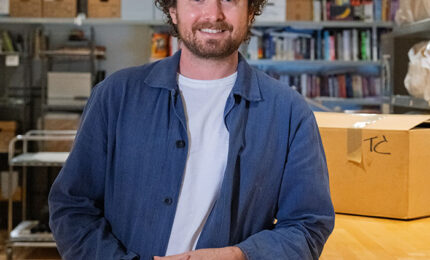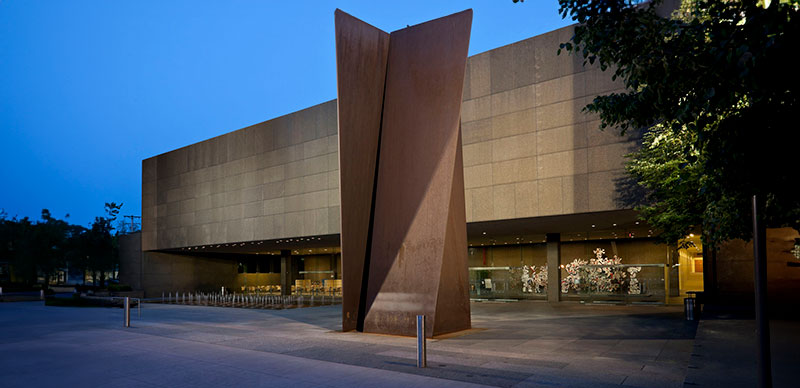As Donald Warhola opens the wooden doors to St. John Chrysostom Byzantine Catholic Church in lower Greenfield (known by locals as “The Run”), the grandson of Andrej and Julia, son of John, and nephew of Andy Warhol is greeted by the warm embrace of memories.
Donald Warhola at the entrance of Andy Warhol’s childhood church. Photo: Renee Rosensteel.
They’re not Donald’s personal recollections, but rather the stories his family would tell, over and over again. The stories he now shares with his son, 13-year-old Andrew, named in honor of Donald’s paternal and maternal grandfathers.
It’s the American Dream story—coming to this country, hoping, praying, and working hard to make a better life for their families.
Andrej and Julia grew up in the Carpathian Mountains, in what is now northeastern Slovakia, making them Carpatho-Rusyns, a legally recognized minority in every country except the Ukraine. After marrying in 1909, they began looking to a future in the United States. Andrej arrived first in 1912 and took on jobs as a laborer in Pittsburgh. Julia joined him nine years later, and three children (Paul, 1922; John, 1925; and Andy, 1928) soon followed.
In 1934, when Andy Warhol was 6, his family was able to buy half of a duplex on South Oakland’s Dawson Street. The home was decorated with symbols of their ever-abiding Byzantine Catholic faith, including an inexpensive reproduction of Leonardo da Vinci’s The Last Supper.
Julia Warhola in 1929 with sons John and 16-month-old Andy
With the Great Depression gripping the country, luxuries were scarce while worries seemed to be plentiful. Faith provided a welcome respite. “There was a sense of security in knowing there was a higher power,” says 56-year-old Donald, who serves as The Warhol Foundation’s vice president and liaison to The Andy Warhol Museum. “Anytime there was a problem, you prayed about it.”
Not surprisingly, church was the one constant in their lives. In fact, Donald adds, they not only talked the talk, they walked the walk—literally. At least once a week, the family would set off on foot to attend Sunday liturgies and other functions at St. John Chrysostom.
With Julia leading the way, they would take a footpath through the woods for their one-mile trek from Dawson Street to Saline Street (where the church resides to this day), which had its share of hills to climb, but cars were fortunately few and far between.
“There was a sense of security in knowing there was a higher power. Anytime there was a problem, you prayed about it.”
– Donald Warhola
In the early 1900s, this area of Greenfield was nicknamed Ruska Dolina, or the Rusyn Valley, because of the large number of Carpatho-Rusyn immigrants who settled there. In 1910 the Greek Catholic Union No. 255 organized the construction of a small wooden building that served as the community’s first St. John Chrysostom. The current church was dedicated in 1935.
Four Mile Run in lower Greenfield, also known as Ruska Dolina (Rusyn Valley), in 1949. Four Mile Run’s name was derived from its distance to the Point in downtown Pittsburgh. The church in the far background is St. John Chrysostom Byzantine Catholic Church, where Andy Warhol was baptized.
Stepping inside, it’s impossible not to be overcome by the colorful imagery. Look up to the domed ceiling, and Jesus is gazing down—a feature added in the 1990s. Lining each side of the church are saints extolled on the beautiful stained-glass windows. Towering in the front above the altar is the dramatic iconostasis, or icon screen.
“The liturgy is about creating heaven on earth,” says Donald, explaining that while the icon screen serves as a physical partition between heaven (the sanctuary or altar) and Earth (the nave or main body of the church), its spiritual intent is to alert all those in attendance to the presence of God. Rising from the floor to the ceiling, the screen features rows and rows of beautifully painted saints and angels—holy men and women who are not meant to be worshipped but to gently guide parishioners to a higher plane of existence.
Archival image of St. John Chrysostom Byzantine Catholic Church in lower Greenfield, 1957
Today’s icon screen isn’t the same one a young Andy Warhol would have witnessed decades ago—it was updated in the 1960s and again in the 1990s. But, then and now, it stands as a testament to the power of the visual, the power of images.
It’s a lesson Warhol learned well. Donald notes that the liturgy’s performative, even theatrical nature that hits on all of the senses—the brilliant sights, the chants of the choir, the smell of the incense—is somewhat reminiscent of his uncle’s raucous “Exploding Plastic Inevitable” multimedia shows of the 1960s. “We never spoke of it, but I could see how he took pieces of it,” says Donald, who worked for his uncle in 1986 installing computers at Andy Warhol Enterprises in New York.
Other lessons were not as easy for Warhol to embrace, especially after moving to New York in 1949 and beginning his life as an openly queer artist—one who remained, albeit it in a less loud and proud way, a practicing Catholic.
Donald Warhola at Sunday liturgy. Warhola loaned to the museum this wooden crucifix given to him by his Uncle Andy.
“He must have been in conflict,” Donald asserts. “But I believe he was able to look beyond that. I believe God doesn’t make mistakes.”
Donald says the topic of his uncle’s sexuality, even during the 19-year span Julia lived with him, wasn’t discussed. “It was never a concern with the family,” Donald says, noting that their concerns were far more basic. “Baba [Julia] would always say that your life is on a thread, it’s very precious. And so, her prayer was always to ask God to bring us home safely.”
When Warhol did eventually return home—to Pittsburgh—it was for his funeral, with a then 24-year-old Donald participating as an altar server. The service was held on February 26, 1987, at Holy Ghost Byzantine Catholic Church on the North Side.
Did the family ever wonder why Warhol wasn’t more public about his faith? “I think Uncle Andy thought it would be boring if people knew he went to church, exercised, and ate healthy,” Donald says. He adds that, according to his father, young Andy had been teased about his faith by other kids during childhood.
Remembered fondly by his family as a kind, caring, and protective son, brother, and uncle, the artist is buried in St. John the Baptist Byzantine Catholic Cemetery in Bethel Park, next to his mother and father and not far from John. In true Warholian fashion, his gravesite is live-streamed 24/7 via The Andy Warhol Museum’s website.
![]()






